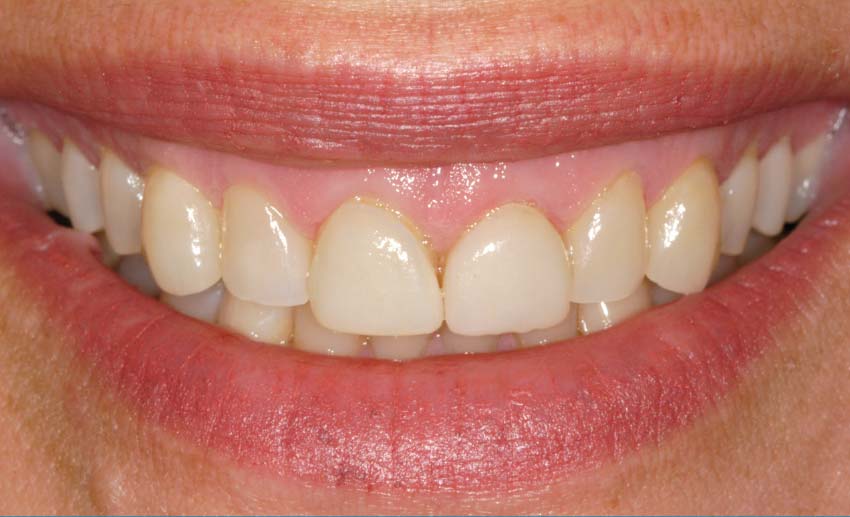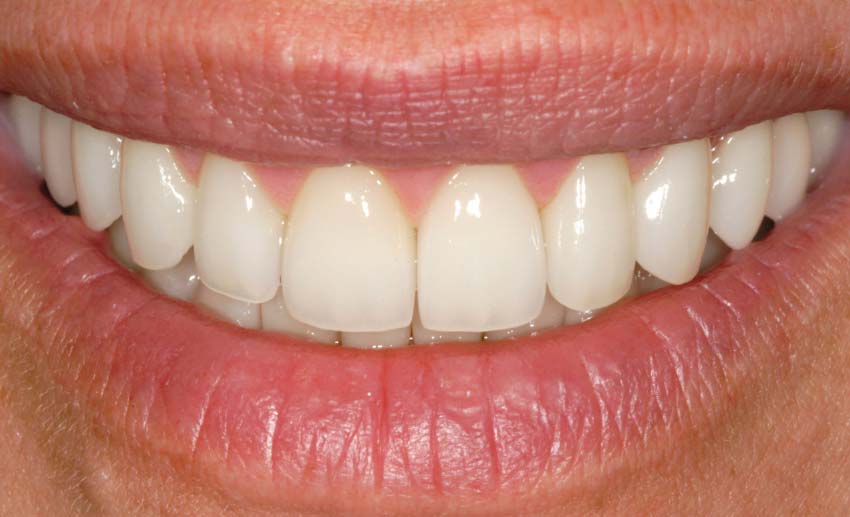Crown Lengthening
This Common Surgical Procedure Restores Function and Improves Appearance
Dear Doctor,
As a senior citizen, I was surprised to get a cavity. What’s more, my dentist says that before it can be filled, I will need a procedure called “crown lengthening.” Can you explain what that is?
Dear John,
Some people think tooth decay affects only the chewing surfaces of the teeth, and is mostly found in children. However, cavities can occur on all vulnerable tooth surfaces, and may be a problem for people at any age; in fact, some studies show that seniors have a higher rate of tooth decay than children. And because of gum recession, older people may develop cavities at or just below the gum line, which are sometimes harder to treat.
 |
| When the upper teeth appear too short, a “gummy smile” can be corrected by periodontal plastic surgery to remove excess tissue and lengthen teeth. |
 |
| After periodontal crown lengthening establishes a more aesthetic tooth length, porcelain veneers can help create a beautiful smile. |
| Dentistry by Dr. Elizabeth M. Bakeman |
If you have a cavity below the gum line, it can’t be filled in the usual way because gum tissue is covering the area that needs to be treated. In such cases, a minor surgical procedure called “crown lengthening” may be necessary. The crown is the visible part of the tooth—so as the name suggests, crown lengthening exposes more of the tooth’s surface, giving the dentist more tooth structure to work with.
When decay reaches under the gum line, a crown lengthening procedure can reposition the gum tissue further away from the biting surface of the tooth, so the cavity can be filled. It can also be used to treat other dental conditions—for example, to restore a tooth that is broken near the gum line or place a crown or bridge on teeth that have too little healthy tooth structure remaining. A prosthetic crown (sometimes called a cap) will not attach properly if there is not enough tooth surface to hold onto. An ill-fitting crown may damage gum tissue, resulting in eventual bone loss, or permit decay to occur under the crown, leading to more significant dental problems.
In addition to dental restorations, crown lengthening is popular in cosmetic dentistry. This procedure—sometimes called a “gum lift”—can improve aesthetics for people who feel that their teeth are too short, or that too much gum tissue shows when they smile. Having an uneven gum line can also make even straight teeth appear irregular. By changing the visible gum-to-tooth ratio and gum contour, crown lengthening can greatly improve a “gummy” smile, make teeth appear longer and straighter, and improve symmetry. Adjusting the gum line for a better smile is not always a purely cosmetic endeavor: When there is too much gum tissue, an individual can be more susceptible to gum infections.
Crown lengthening is performed by some general dentists, but is more commonly referred to periodontists: dentists who specialize in treatment of the gums and other supporting structures of the teeth. The procedure is typically done in a dental office using the kind of local anesthesia you might get for a normal tooth filling, sometimes in combination with a sedative medication.
After anesthesia, your dentist begins the procedure by making small incisions in the gum, which allows a tiny “flap” of tissue to be lifted out of the way. The underlying bone tissue is reshaped to properly support the gum tissue in its improved position. The flap of tissue is then repositioned and sutured into place, following the contours of the gum line. This exposes sufficient tooth surface to reestablish the proper size of the teeth for an appealing and very natural look.
Crown lengthening, like all types of minor surgery, has accompanying risks such as bleeding and infection. Your dentist will give you post-operative instructions to minimize these risks. For the first few days after the procedure, your dentist may advise you to stick to soft food, avoid vigorous physical activity and use an ice pack when needed. You may need a prescription or over-the-counter pain reliever, and you may be prescribed an antibiotic to reduce the chance of infection. The initial soreness you may experience will decrease in a few days.
If tooth restoration is necessary, it will not happen on the same day as crown lengthening. First, the gums will be allowed to heal for 6-12 weeks. This helps ensure that the gums are in their final position so the tooth restoration will look natural.
The crown lengthening procedure is considered irreversible, since it usually involves removing some bone. For this reason, it is important to consider and discuss all current and future treatment options.
Whether it’s done for functional reasons (to help restore your oral health), or aesthetic reasons (to improve appearance), crown lengthening can save a tooth—or even save your smile. If you are wondering whether it could be right for you, ask your general dentist or periodontist.




